Here are the best stories we came across last week.
Before we jump in, I want you to know that this week’s Monday Roundup is sponsored by Splendid Cycles, an excellent source for cargo bikes that will redefine how you travel.
DC’s dockless principles: Washington D.C. managed the first successful, large-scale bike share in the U.S., so it makes perfect sense that they are tackling the challenges of dockless systems head-on. Seems like New Seasons could give this a try!
Bike share 101: Bike share is changing fast. This post from CityLab is a great summary of where things stand. One big takeaway? We must use less road space for driving and give more space to bike share.
Groceries by bike: A major UK grocery store chain has returned to its delivery roots by employing a fleet of electric cargo bikes to distribute products to its customers.
Invisible cars: In the wake of mounting hysteria over dockless scooters, a writer for SF Gate has coined the term “car blindness” to describe the phenomenon of conveniently ignoring the physical and societal impacts of cars.
A cautious governor: In their endorsement of Kate Brown for Oregon Governor, the Willamette Week said she remains, “Too unwilling to challenge the preconceived notions of her base, and simply not bold enough for the challenges that we face.” That is certainly the case when it comes to her treatment of ODOT.
They give you wings: If you’re as fascinated with the dockless scooter wave as we are, don’t miss this NY Times profile of the man behind Bird. “Go back to the early 1900s, and people would have a similar reaction to cars because they were used to horses,” he said. “They had to figure out where to park all the dockless cars.”
Tide turning on cars?: Feels like there’s a lot of momentum lately for the idea that cars and cities just don’t mix. This epic takedown in the NY Times op-ed pages is a case in point.
“Vehicular terrorism”: When you combine the abuse of driving privilege with transportation infrastructure networks that provide little to not protection for people who aren’t driving — it’s no surprise people use their cars as weapons.
Advertisement
A federal “no drive list”?: A New Jersey lawmaker has introduced an anti-terrorism bill that would increase regulation so that suspected terrorists would be barred from renting vans and trucks.
Deaths spike in Los Angeles: An unnerving increase in fatal traffic crashes involving bicycle riders in LA is adding urgency to debates over road diets.
Air quality app: Developers have created a novel way to give context to urban air pollution levels: The “S***! I Smoke” app takes particulate matter data and creates an equivalent represented as a number of cigarettes. (Spoiler alert: In Portland, it’s 0.9 cigarettes per day.)
Road to zero: Using a “safe systems” approach, the National Safety Council is leading the first national strategy to eliminate traffic deaths in the United States by the year 2050.
Then there were three: Colorado has become the third state (after Idaho and Delaware) to make a common sense update to traffic laws so that bicycle users can “slow and go” when they come to stop signs and red lights.
Doomed: A highly respected, UK-based social science researcher says bluntly that the planet is “doomed” because we won’t stop burning fossil fuels.
Montreal moving forward: Add this Canadian city to the list of places where elected officials are moving boldly ahead with street plans that dramatically reallocate space and reduce driving capacity.
— Jonathan Maus: (503) 706-8804, @jonathan_maus on Twitter and jonathan@bikeportland.org
Never miss a story. Sign-up for the daily BP Headlines email.
BikePortland needs your support.



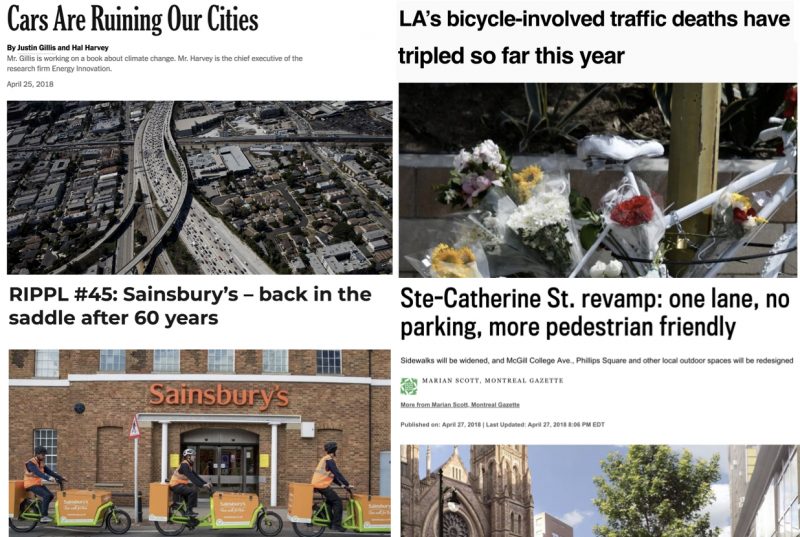
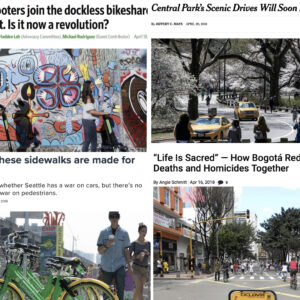
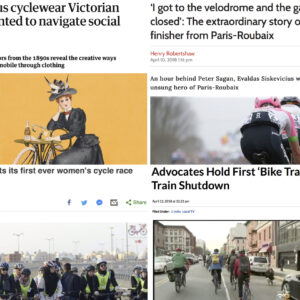
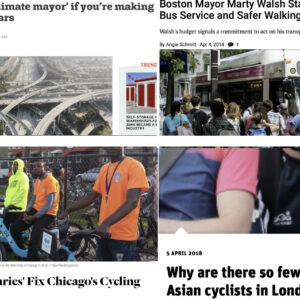
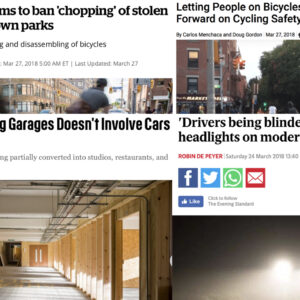
Thanks for reading.
BikePortland has served this community with independent community journalism since 2005. We rely on subscriptions from readers like you to survive. Your financial support is vital in keeping this valuable resource alive and well.
Please subscribe today to strengthen and expand our work.
The take-home message from the bikeshare article is “… it’s time to take space away from cars to create more space for bikes and bike parking.” JM mistakenly wrote, “We must use road space for driving and give more space to bike share” which kind of garbled the message.
Also, a fascinating message was hidden in there about the fact that the addition of dockless bikeshare to the DC streetscape has led to an increase in the use of Capital Bikeshare, the docked system. I like what that implies about a bigger pie being created by these dockless systems.
New Seasons may be better at delivering groceries by bike than tackling the challenges of a dockless bike share : )
Better than behind the wheel of a car though.
To be fair the majority of people who use rental bikes in Seattle are commuters, tourists, and students using them to get around and enjoy the city. Bike share is by far not the exclusive domain of the drunk who thinks it might be fun.
I found the same thing when I spent a weekend in Seattle back in January. Yes, dockless bikes were everywhere, but I didn’t see that many parked inappropriately.
I thought the biggest problem with the system was poor maintenance on a disturbing number of the bikes. Sometimes I had to check out two or three bikes in a row to get one where everything was working: all gears usable, brakes actually stopped the bike, handlebar was on straight, pedals weren’t bent, saddle didn’t tilt back and jam its nose into your perineum, etc. Ofo was the worst of the systems in this regard and Lime was the best, but I had problems with bikes from all three.
Notably, I found with some of the apps (can’t remember which) I couldn’t report a bike with problems once I’d clicked “done” to check it back in. The apps could use a little work, still.
The article on “cars are ruining our cities” made me think of the extreme irony of modern urban life. People rush to work in cars, stuck in traffic jams, looking for parking, trying to save a few extra minutes so they can save up their nickels and go on vacation to Venice, or Florence or Amsterdam or somewhere that has not had its soul sucked out by the motorcar. Maybe if we made our home more like these places we could slow down and reclaim our souls during daily life rather than just when on vacation.
Likewise, increasing numbers of Americans are traveling to Portland to experience a “European” city that hasn’t completely been destroyed by cars. I can only hope a few of Portland’s tourists return home with a desire to push back against automotive dominance everywhere, not just a few select coastal cities.
A fool and his money are quickly parted.
Baguette, miseur?
What is called car blindness is what I’ve been calling windshield entitlement complex over the past few years.
Oh, and in that article is a reference to “The worst bike lane in the world”. Hmm, we’ve got that in Eugene, only with more traffic, which makes ours worse. Oh boy, I live in the city with the worst bike lane in the world!
It’s northbound on River Road at the Belt Line freeway on-ramp. Here’s an attempt at the Google Maps links (one is an attempt to show the signage since the satellite image has the right turn arrow to the left of the bike lane blocked by a car).
https://goo.gl/maps/1pj3p6VM8AG2
https://www.google.com/maps/@44.0964258,-123.1280516,70m/data=!3m1!1e3
That link for Orinda, CA was at least a tad specious, I looked on Google maps, they did cave to the “aesthetic” concerns and add dashed green paint to indicate it’s a merge zone at least 18 month ago https://goo.gl/maps/vwCztdVbMdN2 It is still a stupid idea to have a freeway onramp have a lane that needs to cross the bike lane, but probably not most dangerous in the world if it ever was. For a humorous take there’s always this classic GCN video of the 9 worst cycle lanes https://www.youtube.com/watch?v=Se6jLGF5_a8
Yes, but they fixed it by adding “Yield to Bikes” on the sign. Problem solved–nothing to complain about here!
From the archives… as you can guess, there’s a long backstory:
“After your November 2015 e-mail about this issue, County engineering staff visited the intersection and noted that the gore point pavement striping on Homestead at the far side of the intersection in both directions was missing. The gore line striping, consistent with the Expressway Bicycle Accommodation Guidelines (BAG), has been added as can be seen in the attached photos. The gore line striping provides a consistent width for the right hand through lane on both sides of the intersection while also providing bicycle travel room adjacent to the triangular island.
As an additional improvement, advanced bicycle/pedestrian crossing signs were installed along both directions of Lawrence Expressway for right turning traffic onto Homestead.”
Ah yes… the “gore line” striping (wider white paint), which drivers clearly discern as a signal to check their mirrors and yield to bicyclists while signalling their turn.
Oh, and I both drove and rode this section with the GoPros… had to go back and review the footage before actually noticing they did indeed put a ‘bike/ped Xing’ sign in – clearly confirming my inattentiveness as a driver!
https://goo.gl/maps/3Hh9WTbsvGq
The “no drive list” proposal is a small step in the right direction. We have a serious problem with intoxicated drivers and a huge percentage of them (most?) are driving without valid licenses. We need a statewide, or national, list of people who are not allowed to own a car because their license has been suspended or revoked. If you loan a car to one of them without checking the list, you lose the car.
I’d go a step further and argue that we need an extensive network of cameras that are constantly scanning license plates and faces of drivers, and cross-checking them against the list. There is no expectation of privacy in public spaces, and we should take advantage of that really crack down on the abusers.
The police already gather and process plate scan data from units attached to some cruisers. We could start by adding the worst offenders like multiple DUI based suspensons to the flag list.
Why not just all citizens, so we don’t discriminate based on personal choices.
Right, because we should be just as concerned about an unlicensed person walking as we are of an unlicensed person driving around in a 2,000 to 30,000lb metal box. They are exactly identical.
Licensed drivers are a far bigger threat than unlicensed ones.
About the only way to lose a license in Oregon is to be caught and convicted four times for DUII. (Remember the first one each decade is a freebie eligible for diversion.) Where I live, the majority of the DUII convictions are the result of the intoxicated driver crashing into something hard enough that s/he can’t drive away; we don’t do much patrol. I’d say anyone who can manage that is demonstrably more of a threat than the average licensed motorist. We definitely need to raise the bar for getting a license, but it seems to make sense to me to go after the worst of the worst first.
Ha ha, no.
Far more people are injured or killed by licensed drivers than unlicensed ones. Perhaps on a per-driver basis an unlicensed driver is more dangerous, just as ebola is more dangerous than the flu, but the flu is definitely a bigger threat.
For example, Google tells me that in 2012, 100% of fatal crashes in Napa Valley were caused by licensed drivers.
Drivers with suspended or revoked licenses are much more likely to drive drunk and kill people at a rate much higher than licensed drivers. It is definitely a serious problem that states seem to do little to nothing about. http://abcnews.go.com/Travel/story?id=118913&page=1 As we approach Pedalpalooza I am reminded that this summer will mark 15 years since Orion and Angela were killed by Lindsey Llaneza a repeat drunk driver with a suspended license and a blood alcohol level 3 times the legal limit. He has not reoffended for only one reason, and that is that he is still in prison. Unfortunately as is typically the case very little was done until he had killed people.
Why does Middle of the Road Guy constantly make false equivalence red herring statements in order to make some sort of statement? Is it because the statements being made can’t be justified in more reasonable ways?
Because traveling on foot, which is a right and poses little danger to others, is fundamentally different from traveling by car, which is a privilege and poses great potential danger to others.
We must be careful here. Once such a system was in place to prevent irresponsible drivers from being in a car or an airplane or even public transit it might be used by an autocratic government to punish those who rebel or speak up against it. Before you know it , all the rebels, revolutionaries, free thinkers, and protestors will be traveling about exclusively on bikes and the cars will be filled with imperial toadies. Wait, thats kind of like now.
Do we really need a new wide-reaching police monitoring program that restricts people on a secret list from conducting ordinary activities without due process or public accountability?
It’s a big step in the wrong direction.
Perhaps not, but freedom from being denied services for being on a secret police list is (or should be). Flying’s not a right either, but that doesn’t make the no-fly list acceptable.
How would you feel about using the PPD’s gang list to deny access to rental cars? That is almost exactly the same thing.
We currently have a system for ensuring people who aren’t allowed to drive don’t rent vehicles — we check their license.
I think the whole point was that the current system of just checking driver licences for rentals has not been working. Car based terrorist attacks are on an exponential rise worldwide after terrorist groups started calling for them.
It’s pretty easy to buy a car or van for what it would cost to rent the thing for two weeks – without any kind of license or proof of anything.
You can’t just start revoking rights (or privileges) without due process. A free society just doesn’t work that way.
Make the list public.
Another great use for a list like the one you propose would be to weed out potentially unsuitable job candidates. I certainly wouldn’t want to hire anyone who was unable to meet the very low bar of being able to keep themselves off a no-drive list. I probably wouldn’t rent to them, either, because inability to drive means it might be harder for them to hold down a job (because who would hire such a person?), which would make them less likely to pay the rent on time.
I think China beat us too it with their ” Social Credit” system.
Many employers already require employees to have a valid drivers license, so I think this is already allowed.
Saying this with no irony or humor intended, I applaud any measure that reduces the legal and/or civil rights of MOTOR vehicle operators and makes them feel watched and, honestly, a little oppressed–they damn well should be!
Cars that start with chipped driver licenses linked to that list…
Regarding the LA Times article : “after a certain point, more cars make the city a less congenial place for strollers, bicyclists and people who take public transit to their destinations.”
This is where Portland is at.
There’s quite a leap from “no expectation of privacy” to building a network of cameras designed to spy on ourselves, giving police and government agencies free access to information about our movements for as long as they care to store it.
How about just making the owner of a car legally responsible for what is done with the car? (Yes that would really ding the car rental business)
Australia (from whence I came in 2004) has a similar federal system to the USA. Each state and territory makes extensive use of speed and red light cameras and random breath testing (sobriety road blocks). The registered owner of a vehicle photographed violating the speed limit or running a red light will receive a citation in the mail and will be assumed to be the driver for the purpose of losing licence points. Upon receiving the citation, the owner of the vehicle can complete a section on the back of the form to identify the actual driver or pay the ticket and cop the points – signing the statement is done under the laws of perjury, so if you falsely identify someone you could be in big trouble. No state (as far as I am aware) has evidentiary rules requiring a photograph of the actual driver. A car owner is assumed to know who is driving his/her car (and most cars there as here are only ever driven by one person). The constitutionality of all these practices has been challenged in court and accepted as constitutional by the Australian courts. The upshot: Australia makes the vehicle owner responsible for what’s done with it (insurance also attaches to the car not the driver). If a vehicle is registered to a corporation the corporation either pays a triple fine, or identifies the driver (rental car companies charge your credit card for the fine and send your information to the appropriate DMV).
I know that Oregon has outlawed random breath testing, and severely restricts the use of speed/red light cameras, but I think both those policies make our roads less safe for all users. I don’t particularly enjoy being tailgated while I am driving at the speed limit in the right hand lane of a multi-lane road, while being passed by other vehicles whose drivers seem to think the Oregon Road Code doesn’t’ apply to them. KATU ran a story last night about slow drivers causing crashes, I don’t think that’s right, I think lack of enforcement is what is encouraging even more speeding and aggressive behavior.
I wonder if Portland could permit slow-and-go the way they allow parking near corners — simply announce publicly that the police will deprioritize ticketing of cyclists who (safely) don’t stop for a stop sign.
This was atttempted by the Idaho Style team, it met with a lot of resistance from PPB and was eventually determined to not be a viable path to the goal in part because it allows cyclists who are riding safely to be painted as scofflaws.
The van attack in Toronto the other day, an echo of the one on the Hudson River Trail in Manhattan (NYC), has promoted talk of placing concrete barriers separating sidewalks and bike lanes from auto traffic. Toronto started doing that along the street where their incident took place last week, just a few days after the attack. NYC did the same thing after the one last year on the stretch where it happened. (I follow CBC on Facebook, so I got to see CBC’s coverage of the afermath of that attack.) Removing traffic lanes to create more space for ped/bike paths helps lower the possibility of such incidents. Trump’s ignorance doesn’t help either. Nor does his idea that America needs, as he put it at the last State of the Union, “gleaming new roads.” That concept is illogical. We need more ped/bike paths and Greenways, not freeway expansions.
My experience is anecdotal and potentally unrepresentative, but then so is Napa valley. I have been involved in or witness to numerous car-on-car crashes over the years.
In the majority of these crashes, the person who appeared to be at fault was an unlicensed driver. They may not be a majority of drivers, but their numbers are significant (I’ve actually heard in the past that 20-30% of drivers in OR are unlicensed) and they cause a disproportionate share of mayhem.
Hope this is not too anecdotal…
https://crashstats.nhtsa.dot.gov/Api/Public/ViewPublication/812046
Only 19%, huh? That’s lower than I would have thought based on ULM stats I’ve seen quoted before.
~10% of drivers on the road are unlicensed.
BUT, unlicensed drivers account for 19% of motor vehicle fatalities. They are 3x to 4x as likely to be drunk when stopped. They are more than 5x as likely to hit & run drivers, in cases where the drivers were actually caught.
I guess you can decide what kind of driver is more dangerous.
I agree unlicensed drivers are more dangerous, per driver, than licensed ones. Because of their relatively low numbers, they are less of a threat.
10% is not a low number of unlicensed drivers. There you go again, minimizing the threat of something you don’t personally think is dangerous.
If you prefer raw numbers, that’s 55 million unlicensed drivers in the US who are 2x as likely to kill someone, 3x to 4x as likely to be drunk, and 5x as likely to be a hit & run driver.
I will repeat: I agree unlicensed drivers are more dangerous, per driver, than licensed ones.
This article shows the percent of unlicensed drivers in Oregon at about 4.5%. If the national statistic (18% of fatal crashes and 19% fatalities involve an unlicensed driver) holds true here, than that is starkly disproportionate. Yes, your earlier point about greater total harm from licensed drivers is still technically true. But I certainly can’t disregard that danger as a small contribution to the problem (a la your ebola analogy).
*This* article: http://www.oregonlive.com/politics/index.ssf/2014/01/oregons_unlicensed_uninsured_d.html
This tube for bikes and pedestrians moves people through a weather-resistant elevated pipeline.
http://www.hayden-island.com/columbia-tube/
Cool! How do we have that in Portland without people camping inside it?
Hi, i just wanted to mention that there is a little college town named Monmouth that has deployed dockless bike share. I drove through it recently and saw people riding orange bikes everywhere… a place you would rarely see people ride bikes. It has a large university population, too. I suspect the bike shop there was responsible.
Sorry, no pictures!